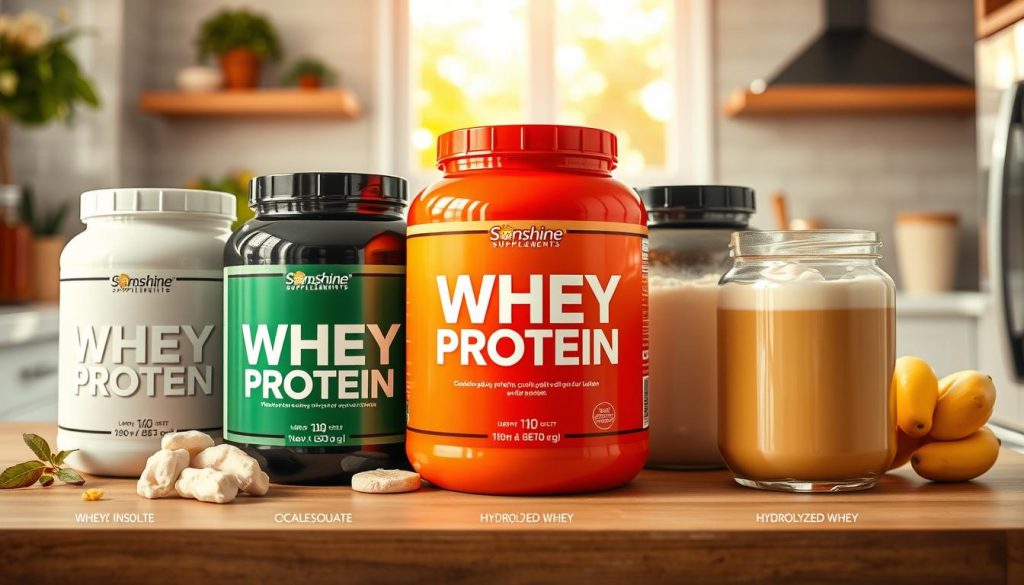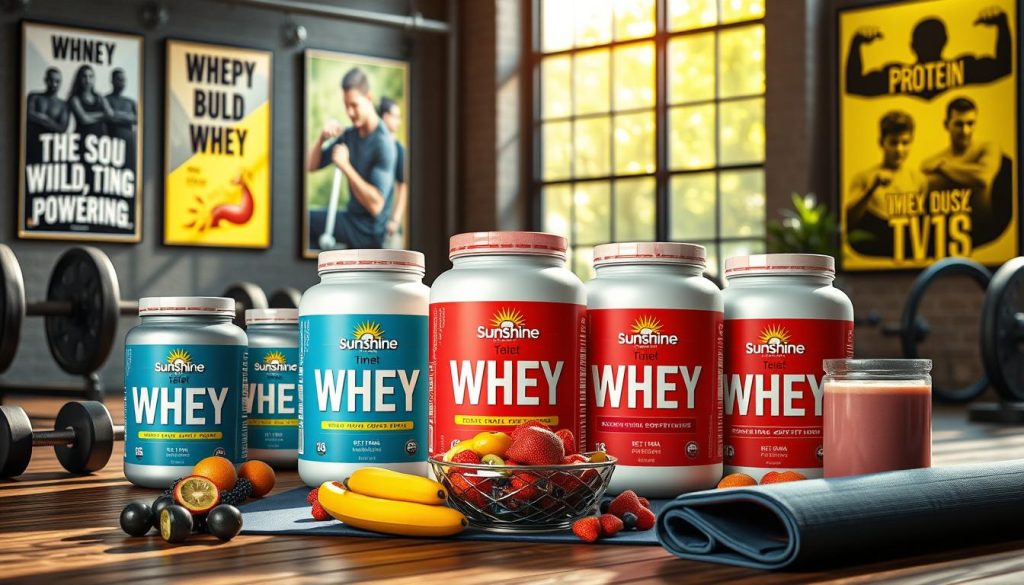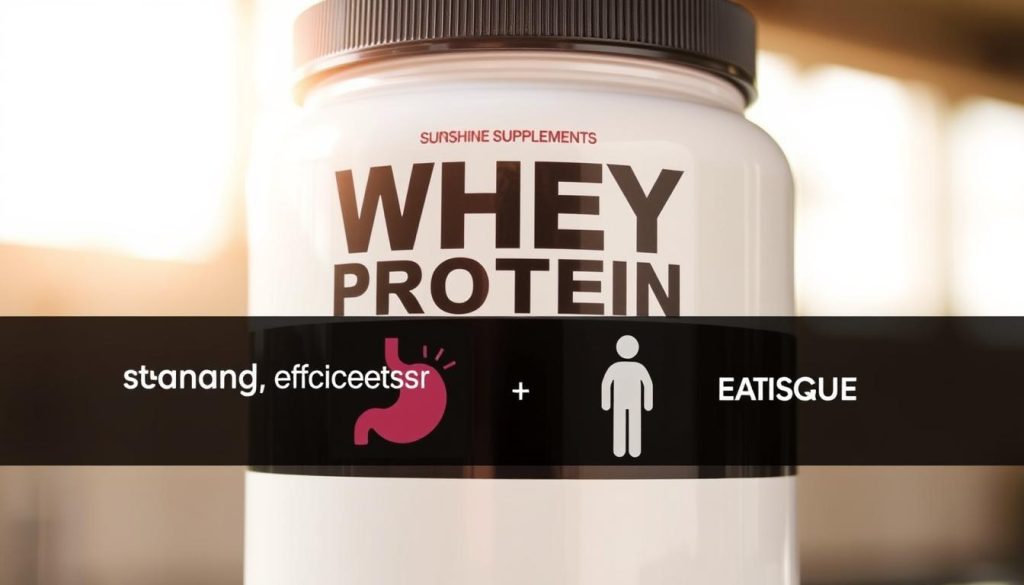Did you know whey protein concentrate can have up to 80% protein? This powerful supplement comes from milk and is a big help for those who work out and care about their health. It has all nine essential amino acids, helping muscles grow, recover faster, and improving overall health. This guide will show you how to use whey protein to get the most benefits.
Key Takeaways
- Whey protein is a complete protein source with a high amino acid profile
- Protein needs vary based on activity level, ranging from 0.8 to 2.0 grams per kilogram of body weight
- Timing whey protein intake, around workouts, can enhance muscle recovery and growth
- Selecting the right type of whey protein (concentrate, isolate, or hydrolysate) is key
- Proper mixing and preparation methods can optimize the benefits of whey protein
Understanding What Whey Protein Is
Whey protein comes from milk and is a top choice for many. It’s packed with essential amino acids that help with health and fitness. Let’s dive into the types, their benefits, and how it’s made into a protein powder.
Types of Whey Protein
There are three main types of whey protein:
- Whey Protein Concentrate (WPC): This has 70-80% protein and is great for most people.
- Whey Protein Isolate (WPI): It’s at least 90% protein, perfect for those wanting less fat and carbs.
- Whey Protein Hydrolysate (WPH): Known as “pre-digested” whey, it’s easy for the body to absorb, great for those with sensitive stomachs.
Nutritional Components
Whey protein is full of branched-chain amino acids (BCAAs), like leucine. These are key for muscle growth and recovery. It also has all the essential amino acids, making it a complete protein source.
Manufacturing Process
To make whey protein, whey is separated from milk, filtered, and turned into powder. This process keeps its nutrients while making it easy to use as a supplement.
Knowing about the different whey proteins, their nutrients, and how they’re made helps you choose the right one for you.
Benefits of Whey Protein for Health and Fitness
Whey protein is a versatile supplement that offers many benefits. It’s a rich source of essential amino acids. These help grow muscles, recover from workouts, boost your immune system, and aid in weight management.
Whey protein is great for building muscle. It has a lot of leucine, which helps your muscles grow and repair. This makes it perfect for athletes and fitness lovers who want to increase their muscle growth. It’s also absorbed quickly, which helps your muscles get the nutrients they need fast. This reduces recovery time and boosts performance.
Whey protein also supports your immune system. It has immunoglobulins and lactoferrin, which help fight off illnesses. It also has anti-inflammatory properties. These can improve heart health and lower the risk of chronic diseases.
Whey protein is also good for weight management. It’s high in protein and can make you feel full. This helps you stick to a calorie-controlled diet. It also has a thermogenic effect, which can slightly boost your metabolism. This helps with weight loss.
| Whey Protein Benefits | Details |
|---|---|
| Muscle Growth | Whey protein has lots of leucine, which is key for muscle growth. It helps build and repair muscles, best when used with resistance training. |
| Immune System Support | Whey protein is full of immunoglobulins and lactoferrin. These boost your immune system and reduce inflammation. |
| Weight Management | Whey protein’s high protein and thermogenic properties help control hunger, boost metabolism, and support weight loss. |
Adding whey protein to your daily routine can be very beneficial. It’s good for building muscle, boosting your immune system, or managing your weight. Always talk to a healthcare professional before starting any new supplement. They can help make sure it’s right for you.

How to Take Whey Protein: Dosage and Timing
Adding whey protein to your diet can really help you reach your fitness goals. But, knowing the right whey protein dosage and best times to take whey protein is key. Let’s explore the details.
Calculating Your Protein Needs
Your protein intake depends on several things. These include your activity level, body weight, and fitness goals. Here’s a basic guide:
- Sedentary people might need about 0.8 grams of protein per kilogram of body weight.
- Those who are moderately active might need 1.2-1.5 grams of protein per kilogram of body weight.
- For athletes or those in intense training, 1.6-2.0 grams of protein per kilogram of body weight is often needed.
It’s important to figure out your specific protein needs. This helps you get the most out of whey protein and reach your fitness goals.
Best Times for Consumption
The best times to take whey protein are:
- Post-workout: Taking whey protein within 30 minutes to an hour after exercise helps with muscle recovery and growth.
- Between meals: Whey protein can help increase your daily protein intake and support muscle development.
- Before bed: Casein protein, which is slower-digesting, is good for overnight muscle repair and recovery.
Post-Workout Guidelines
To best support muscle recovery and growth, aim to consume 20-40 grams of whey protein within 30 minutes after working out. This amount depends on your body weight and how hard you worked out. This timing gives your muscles the nutrients they need to repair and rebuild. It can improve your performance and physique.
“Whey protein can be a valuable addition to your diet, but the key is finding the right whey protein dosage and timing that works best for you and your fitness goals.”
Choosing the Right Type of Whey Protein
When it comes to types of whey protein, you have two main choices: whey protein concentrate (WPC) and whey protein isolate (WPI). Your choice depends on what you need and like.
Whey Protein Concentrate (WPC) has a protein level of 35% to 85%. It also has lactose and fat. It’s cheaper and keeps more nutrients from whey. Whey Protein Isolate (WPI) has a protein level of 90% or more. It has less carbs and fats.
WPI is seen as the top choice for many reasons:
- It has more protein, often 20-22% glycomacropeptides (GMP) with health benefits
- It’s of high quality and full of milk bioactives like BCAAs
- It’s made using cross-flow microfiltration (CFM), keeping proteins intact
When picking between whey protein concentrate vs isolate, think about your protein needs, how well you digest it, and your fitness goals. If you can’t digest lactose well, WPI is better. For high protein intake, WPI is the best.
The best whey protein for you depends on your needs and likes. Talk to a health or fitness expert to find the right whey protein for your goals.

“Whey protein is a high-quality, rapidly absorbed source of protein that can support muscle building, recovery, and overall health.”
Mixing and Preparation Methods
Making the perfect whey protein shake needs some skill. Whether you’re into fitness or just want more protein, learning how to mix whey protein is key. We’ll cover shake recipes, blending tips, and how to store it.
Basic Shake Recipes
A good whey protein shake starts with a simple recipe. Begin with 1 scoop of your favorite whey protein powder. Then, mix it with 8-10 ounces of water, milk, or plant-based milk. You can add fruits, nut butters, or other healthy ingredients for taste and nutrition.
Make sure to blend or shake well. This ensures your shake is smooth and free of lumps.
Blending Tips and Techniques
- Use cold or room-temperature liquids to prevent clumping and ensure a smooth texture.
- Shake or blend for approximately 10-20 seconds to achieve the perfect blend.
- Avoid over-blending, as this can lead to a thicker, foamier texture.
- High-quality whey protein powders will generally mix more easily than some of their counterparts.
Storage Guidelines
Keeping your whey protein powder fresh is important. Store it in a cool, dry place. And drink any mixed shakes right away for the best taste and nutrition. Whey protein is sensitive to temperature and moisture, so keep it cool and dry.
With these tips, you’ll make tasty and healthy whey protein shakes. Try out different recipes and techniques to find your favorite protein shake!
Whey Protein for Different Fitness Goals
Whey protein is great for reaching your fitness goals. It helps with muscle building, weight loss, and improving athletic performance. Let’s see how to use whey protein for each goal.
Muscle Gain
For muscle building, whey protein is key, best taken after working out. Whey protein concentrate, with 70-80% protein, is perfect. It has lots of BCAAs, like leucine, which helps muscles grow.
Weight Loss
Whey protein aids in weight loss too. Its high protein content keeps you full, reducing hunger. Use it as a meal or snack to control calories and aid in losing weight.
Athletic Performance
Whey protein is essential for athletes. It repairs muscles, replenishes energy, and boosts performance. Adjust your whey protein intake based on your training to get the most benefits.
It’s vital to watch how your body reacts to whey protein. Adjust as needed. Talk to a healthcare professional or dietitian to find the right amount for you.
| Activity Level | Protein Intake Recommendation |
|---|---|
| Sedentary | 0.8 grams per kilogram of body weight |
| Light Physical Activity | 1.0 grams per kilogram of body weight |
| Regular Exercise | 1.2-1.5 grams per kilogram of body weight |
| Intense Physical Training | 1.6-2.0 grams per kilogram of body weight |
Remember, whey protein for weight loss, whey protein for muscle gain, and protein for fitness goals are key. Tailor your whey protein use to your needs for the best results.

“Whey protein is a versatile and effective tool for supporting a wide range of fitness goals, from muscle building to weight management. By understanding how to optimize your intake, you can unlock the full potentia of this high-quality protein source.”
Common Mistakes to Avoid When Taking Whey Protein
Adding whey protein to your diet can really help with your fitness goals. But, it’s key to watch out for common mistakes. These can mess up how well it works and even cause bad side effects.
Dosing Errors
Many people take too much whey protein, thinking it’s better to have more. But, taking too much can cause stomach problems like bloating and diarrhea. It can also add too many calories. Stick to 20 to 40 grams per serving, based on your needs and goals.
Mixing Problems
Not mixing your whey protein shake right can ruin its taste and quality. Don’t use hot liquids, as they can damage the protein. Use cold water, milk, or a dairy-free option instead. Make sure to blend well for a smooth shake.
Timing Mistakes
When you take whey protein matters a lot. Not taking it right after working out or not eating enough protein all day can hurt its benefits. Try to drink your shake within 30 to 60 minutes after working out. Also, spread out your protein intake throughout the day.
By avoiding these whey protein mistakes, protein powder dosage errors, and protein timing errors, you can get the most out of this supplement. This will help keep your fitness journey on track.
Side Effects and Precautions
Whey protein is usually safe for most people. But, it’s good to know about possible side effects and precautions. Some might feel bloated, gassy, or have stomach issues, mainly if they can’t digest lactose well. Choosing whey protein isolate can help because it has less lactose.
Start with small amounts of whey protein and slowly increase it. This helps your body adjust and might prevent discomfort. Drinking enough water also helps with digestion and can lessen protein powder precautions like bloating.
If you have health issues or concerns, talk to a doctor before using whey protein. They can advise on safe use and make sure it won’t harm your health or interact with medications.
| Potential Side Effects | Precautions |
|---|---|
|
|
Being aware of whey protein side effects and taking precautions helps you use it safely. This way, you can improve your health and fitness with this supplement.

“Protein powder can be a beneficial supplement to balance diets, helping those struggling to consume enough protein, as long as appropriate serving sizes, suitable protein type, and third-party tested brands are selected.”
Combining Whey Protein with Other Supplements
Whey protein is a versatile supplement that can be mixed with other products for better results. Adding whey protein to your fitness routine can give you a big boost. This is when you pair it with the right supplements.
Whey protein and creatine are a great team. Creatine boosts muscle strength and size. Whey protein helps with muscle growth and recovery. Together, they help you build and keep lean muscle more efficiently.
Whey protein and branched-chain amino acids (BCAAs) also work well together. BCAAs help with muscle recovery, reducing soreness and speeding up your return to training. Taking whey protein and BCAAs around workouts helps your body repair and rebuild muscle faster.
For overall health, consider mixing whey protein with a good multivitamin. This combo ensures you get all the nutrients you need. It supports your immune system and energy levels.
When mixing supplements, it’s important to check for any interactions and talk to a healthcare professional. Always stick to the recommended amounts and timing to avoid any bad effects. It’s all about finding the right balance in your supplement routine.
| Supplement | Typical Dosage | Benefits |
|---|---|---|
| Whey Protein | 10-40g/day | Muscle building, recovery |
| Collagen Protein | 5-20g/day | Joint support, skin health |
| Creatine | 5g/day | Increased strength, muscle growth |
| BCAAs | 5-10g/day | Muscle recovery, reduced soreness |
| Multivitamin | 1 serving/day | Overall health and wellness |
By carefully choosing supplements to go with whey protein, you can make a solid plan for your fitness goals. This plan supports muscle building, recovery, and overall health and wellness.
Whey Protein vs. Other Protein Sources
Whey protein is known for its complete amino acid profile and quick absorption. But, pea or rice protein is good for vegans or those with dairy allergies. Eggs, lean meats, and fish also have nutrients but might not be as easy to get enough protein from.
Plant-Based Alternatives
Pea and rice proteins are good for those who don’t eat animal products. They don’t have all the amino acids that whey does. Yet, they help with muscle growth and recovery, making them great for active people.
Comparison with Natural Protein Sources
Eggs, lean meats, and fish give more than just protein. But, they take more time to prepare. Whey protein is cheaper and easier to add to your day.
Cost-Benefit Analysis
| Protein Source | Protein Content | Cost per Serving | Convenience |
|---|---|---|---|
| Whey Protein | 25-27 g per scoop | $0.50 – $1.50 per serving | High |
| Pea Protein | 24-27 g per scoop | $0.75 – $2.00 per serving | High |
| Eggs | 6 g per large egg | $0.10 – $0.25 per egg | Moderate |
| Lean Chicken Breast | 27 g per 4 oz serving | $1.00 – $3.00 per serving | Moderate |
The table shows that whey protein is a convenient and affordable choice. It’s a high-quality protein source that’s easy to add to your daily routine. Natural sources have more nutrients but are less convenient and pricier, mainly for those needing lots of protein.
Conclusion
Whey protein is a powerful supplement that boosts your fitness and health. It comes in different types, each with its own benefits. Knowing how to use it can greatly improve your health.
Whey protein helps you build muscle, lose weight, and perform better in sports. It supports muscle growth, helps with recovery, and keeps you full. Adding it to your diet and workouts can change your game.
Choose the right whey protein for you and watch out for side effects. Always eat well and exercise too. This guide will help you get the most out of whey protein. You’ll see big improvements in your whey protein benefits, protein supplement guide, and fitness nutrition tips.




